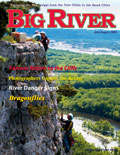July-August River News excerpts and Links
Picking a New Bridge
Quad Cities — The amount of traffic on the I-74 bridge between Moline, Illinois, and Bettendorf, Iowa, exceeded design capacity a long time ago. More than 75,000 vehicles a day pass over the spans. Accidents and breakdowns cause major bottlenecks because the bridge has no shoulders or places to pull off. Planning for its replacement has been going on for some time and in May took another large step forward.
Citizens were given a look at four alternate bridge designs and asked for their input by officials at the Iowa and Illinois departments of transportation, who are jointly developing the project. That input will help lead to a final design selection within the next six months, according to the schedule.
An environmental impact study based on the footprint of the chosen model should be done by June, 2007, and then right-of-way acquisition can begin. All of that should be completed between 2007 and 2010, then, if the local governments have met all the federal criteria, a record of decision will be put in place, which will lead to a request for more than $650 million for the bridge and improvements bluff to bluff in the 2010 federal transportation budget.
The
four designs were termed "a basket
handle true arch twin bridges, a modified basket handle tied arch
twin bridges, a basket handle tied arch twin bridges with vertical
piers and hangers, and a cable stayed single bridge with semi-fan
stay arrangement." The differences are difficult to describe but
can be seen online. To date, the cable stayed single bridge was
the most popular. It is similar to the bridge in Burlington, Iowa.
The
bridge is an important transportation
corridor in the Quad-Cities and one of the most traveled sections
of road in that area. The existing bridge is scheduled to be removed
after the new one is completed, although one citizen has suggested
turning one span into a park with "a path, benches, plants, grasses,
observation deck, restaurant and ice cream stand," while another
suggested keeping one span to use as a bike path and pedestrian
crossing, which might be cheaper than adding those to the new structure.
School on the Cat
Quad Cities — The Channel Cat Water Taxis have combined fun with transportation since 1995. They shuttle more than 37,000 passengers a summer between five docks on both sides of the river. A $5 ticket ($2 for children aged 2 to 10) gets you all-day, unlimited boarding. Riders can get off in one location and resume their journey anytime during the day or evening.
This summer, River Action, Inc., a local nonprofit group that promotes public awareness and connections to the river, will offer a series of classes aboard the taxis from June through the end of August.
On July 6 and 11, and August 22 and 24, participants will get a short course in towboat dangers, lock-and-dam safety, and boating safety.
On July 18 and 20, and August 29 and 31, students will perform hands-on water testing, and learn about watershed practices and their impact on water quality from a state water quality supervisor.
On
July 25 and 27, a retired Augustana College professor will tell
stories about the Moline lock, the Rock Island Bridge, the Civil
War, local city history and the battle of Campbell's Island.
On August 1 and 3, a U.S. Fish and Wildlife Service biologist will talk about habitat diversity and productivity in a large ecosystem.
Photographers are invited aboard on August 8 and 10 to practice and learn local wildlife photography from a local freelance photographer.
On August 15 and 17, a marine operations chief will talk about the transportation industry while the class watches operations at a barge unloading facility.
Classes cost $10 each and will be held on Tuesday and Thursday mornings, from 9 a.m. to 11 a.m. For more information, see the River Action web site or call (563) 322-2969.
|

